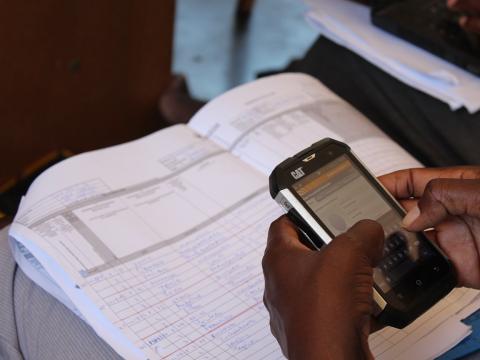Use of LMMS speeds up relief work for over one million people in Zimbabwe

“With LMMS, distribution is faster and more efficient. We now spend two and ½ hours instead of more than four hours that normally took to give out aid to at least 5,067 people,” says Fanny Nyaunga, World Vision Commodities Officer.
The Last Mile Mobile Solutions (LMMS) developed by World Vision, is a stand-alone digital system with functions including beneficiary registration, verification, distribution planning and management, monitoring and reporting. It improves remote data collection, helps manage aid recipients, enables faster and fairer aid distributions and delivers rapid reporting to aid workers. (LMMS Factsheet)
In Zimbabwe where drought is threatening the lives of more than 4.1 million people, World Vision is utilizing LMMS to reduce costs and improve efficiency in providing humanitarian aid. Since its deployment, the technology has improved food aid and cash distribution, making it easier, faster and more dignified for communities in need.

In Hwange, Mount Darwin and Mudzi districts, aid delivery in partnership with the World Food Programme has improved considerably with cash-in-transit, food aid and other programs reaching out to 544,801 beneficiaries. In the past, organizations spent a longer time collecting information. Now, the tool has simplified remote data collection, beneficiary data management and aid distribution monitoring as well as reporting for both beneficiaries and commodities.
“We started receiving aid in June 2016, and I see the change with LMMS) cards."
Nyaunga, who is based in Mount Darwin, hailed the tool as dependable and user friendly. With the shortened distribution time, beneficiaries can go home quickly and work on their farms and household chores. Women in Mukoma welcomed the technology saying it enhances transparency in aid distribution especially where cash is involved.
Tangisai Kachere, a mother of three, says, “We started receiving aid in June 2016, and I see the change with LMMS) cards. They have reduced the risk of fraud because the information is stored in the card. In the past, some can register false information that was difficult to verify. With the card and photo showing the actual person, verification is now easy”.
Susan Dhauka commended the use of cards in distribution points and reiterated that it reduces issues of theft. She says, “One of the fascinating aspects about using a card is that there is no way one can steal from you when receiving cash. That’s when we realised the importance of using this tool.”

The USAID-funded programme, Enhancing Nutrition, Stepping up Resilience and Enterprise (ENSURE) project is also fully utilizing the LMMS in the distribution of food to pregnant and lactating mothers as well as the Food for Asset component. To date 125,403 households have received food rations in Bikita, Chimanimani, Chivi, Zaka, Buhera and Chipinge districts.
“This tool is convenient, registration is done once and the same information can be used in new interventions - saving on time and cost of conducting this process again and again.”
This translates to efficiently serving 627,015 people based on the average household composed of five people. ENSURE’s Commodity Reporting and Logistics Coordinator Langton Gwekwerere said the tool has revolutionized the distribution process. He said it reduced the time in food distribution points from registration by at least 50%, saving time for both staff and beneficiaries. He adds, “This tool is convenient, registration is done once and the same information can be used in new interventions - saving on time and cost of conducting this process again and again.”
Response Manager Goodson Murinye said the technology is already contributing to Core Humanitarian Standards on Quality and Accountability, a voluntary code that has nine commitments that organisations and individuals involved in humanitarian response may use to improve the quality and effectiveness of the assistance they provide. More importantly, the communities they serve can hold them accountable.
“The verification of beneficiaries by their photographs and scanning of ration cards to conduct distributions protects the dignity of beneficiaries. This retains their self–worth in their various capacities in the societies where they are respected for their capabilities and strengths. The aid delivery does not then make them feel less human and don’t leave them negatively affected by the aid delivery activity as contained in CHS commitment,” Murinye further explains.
The advent of Information Communication Technologies such as the LMMS has brought relief to humanitarian organisations. For World Vision in Zimbabwe, the technology has accelerated the organisation’s speed in responding to emergencies such as the El Nino-induced drought among others. The innovation has not only transformed humanitarian assistance process, it has expedited it, ensuring that it reaches beneficiaries on time as well as making a lasting impact in their desperate situations.
